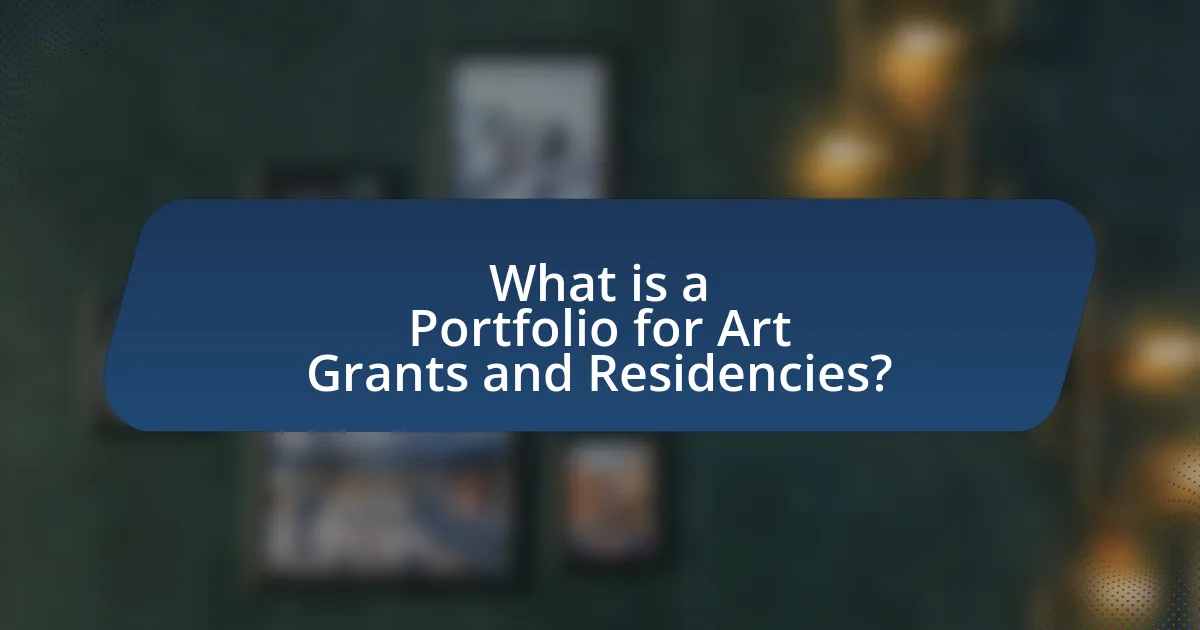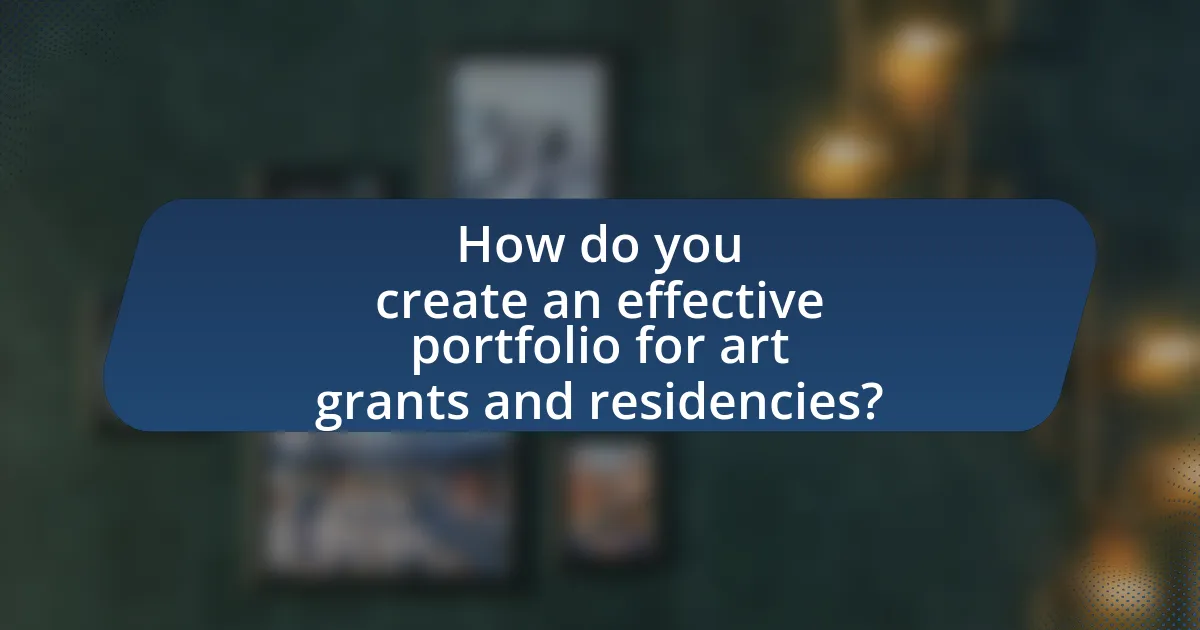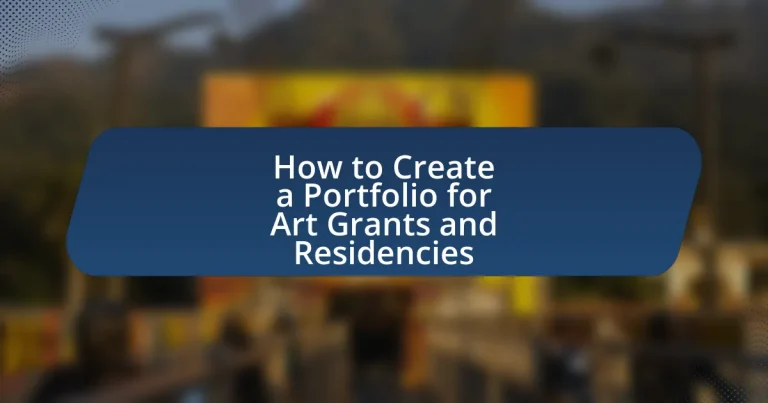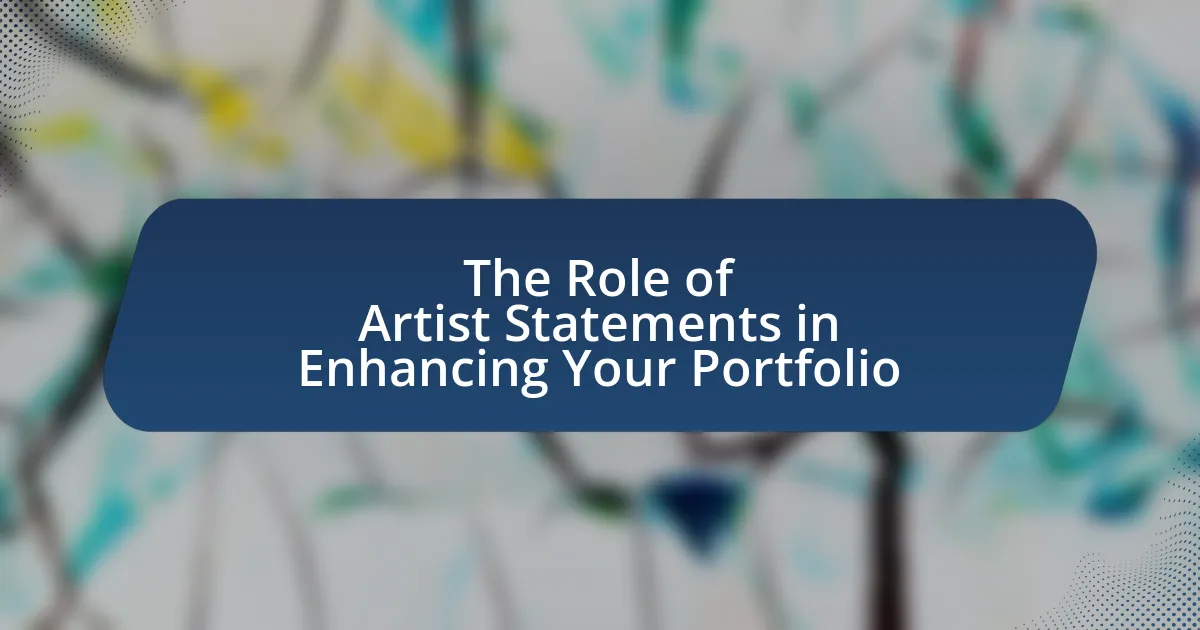A portfolio for art grants and residencies is a curated collection that showcases an artist’s skills, style, and vision, typically including images of artworks, project proposals, artist statements, and a resume. This article outlines the importance of a well-structured portfolio in enhancing an artist’s chances of securing funding or residency opportunities, emphasizing key elements such as cohesive artwork selection, effective artist statements, and tailored presentations. It also discusses the differences between portfolios and resumes, the advantages of digital versus physical formats, and common mistakes to avoid, providing practical steps for artists to create impactful portfolios aligned with specific grant or residency goals.

What is a Portfolio for Art Grants and Residencies?
A portfolio for art grants and residencies is a curated collection of an artist’s work that demonstrates their skills, style, and artistic vision. This collection typically includes images of completed artworks, project proposals, artist statements, and a resume or CV detailing the artist’s background and experience. The purpose of the portfolio is to showcase the artist’s capabilities and to persuade grant committees or residency programs of their potential for success and contribution to the artistic community. A well-structured portfolio can significantly enhance an artist’s chances of receiving funding or residency opportunities, as it provides tangible evidence of their artistic practice and achievements.
Why is a portfolio important for artists seeking grants and residencies?
A portfolio is crucial for artists seeking grants and residencies because it serves as a visual representation of their skills, style, and artistic vision. This collection of work allows funding bodies and residency programs to assess the artist’s capabilities and potential impact. A well-curated portfolio can demonstrate an artist’s commitment to their craft, showcasing not only completed works but also the evolution of their artistic practice. Research indicates that 85% of grant reviewers prioritize the quality of the portfolio when making funding decisions, highlighting its significance in the selection process.
What key elements should be included in an art portfolio?
An art portfolio should include a cohesive selection of artwork, an artist statement, a resume or CV, and documentation of past exhibitions or projects. The cohesive selection of artwork demonstrates the artist’s style and skill, typically featuring 10-20 pieces that showcase a range of techniques and concepts. An artist statement provides insight into the artist’s vision and creative process, helping reviewers understand the context of the work. A resume or CV outlines the artist’s education, experience, and relevant skills, establishing credibility. Documentation of past exhibitions or projects serves as proof of the artist’s engagement with the art community and can include images, press releases, or catalogs. These elements collectively create a comprehensive representation of the artist’s work and professional background, essential for securing art grants and residencies.
How does a portfolio differ from a resume or CV in the art world?
A portfolio in the art world is a curated collection of an artist’s work that showcases their skills, style, and creative vision, while a resume or CV primarily lists an artist’s educational background, professional experience, and accomplishments. The portfolio serves as a visual representation of the artist’s capabilities, often including images of completed works, project descriptions, and sometimes process documentation, which allows evaluators to assess the artist’s aesthetic and technical proficiency. In contrast, a resume or CV provides a textual summary of the artist’s career trajectory, including exhibitions, awards, and relevant training, but lacks the visual impact and depth of engagement that a portfolio offers. This distinction is crucial for art grants and residencies, where the visual presentation of work can significantly influence selection decisions.
What types of portfolios are suitable for art grants and residencies?
Portfolios suitable for art grants and residencies typically include a cohesive body of work that demonstrates the artist’s skills, concepts, and artistic vision. These portfolios should feature high-quality images of completed artworks, a clear artist statement, and a resume or CV highlighting relevant experience and exhibitions. Additionally, including project proposals or descriptions of intended work can strengthen the application, as they provide insight into the artist’s future direction and how it aligns with the goals of the grant or residency.
How do digital portfolios compare to physical portfolios?
Digital portfolios offer greater accessibility and flexibility compared to physical portfolios. Digital formats allow for easy sharing via email or online platforms, enabling wider audience reach without the limitations of physical transport. Additionally, digital portfolios can incorporate multimedia elements such as videos and interactive content, enhancing the presentation of work. In contrast, physical portfolios are limited to static images and require physical storage, which can be cumbersome and less adaptable to changes. The shift towards digital portfolios is supported by the increasing use of online applications for art grants and residencies, where digital submissions are often preferred or required.
What are the advantages of using a themed portfolio?
Using a themed portfolio allows artists to present a cohesive narrative that highlights their unique vision and style. This approach enhances the clarity of the artist’s message, making it easier for grant committees and residency selectors to understand the artist’s intent and focus. A themed portfolio can also demonstrate the artist’s depth of exploration within a specific subject, which can be appealing to evaluators looking for commitment and expertise. Furthermore, a well-defined theme can differentiate an artist in a competitive field, increasing the likelihood of securing funding or residency opportunities.

How do you create an effective portfolio for art grants and residencies?
To create an effective portfolio for art grants and residencies, artists should curate a selection of their best work that demonstrates their skills, style, and artistic vision. This selection should include high-quality images of completed artworks, a clear artist statement, and a concise resume that outlines relevant experience and exhibitions. According to the National Endowment for the Arts, a well-organized portfolio that showcases a coherent body of work can significantly enhance an artist’s chances of securing funding or residency opportunities. Additionally, including project proposals or descriptions of intended works can provide context and insight into the artist’s creative process, further strengthening the application.
What steps should you follow to compile your portfolio?
To compile your portfolio for art grants and residencies, follow these steps: first, gather your best work that showcases your skills and artistic vision. This includes selecting high-quality images or recordings of your artwork, ensuring they are well-lit and accurately represent your pieces. Next, create a cohesive narrative by organizing your work thematically or chronologically, which helps reviewers understand your artistic journey. Then, write an artist statement that articulates your creative process, influences, and the concepts behind your work. Additionally, include a resume that outlines your education, exhibitions, and relevant experiences in the art field. Finally, review the specific requirements of each grant or residency application to tailor your portfolio accordingly, ensuring it meets their guidelines and expectations.
How do you select the best works to include in your portfolio?
To select the best works for inclusion in a portfolio, prioritize pieces that showcase your unique style, technical skills, and thematic consistency. Evaluate each work based on its relevance to the specific art grant or residency requirements, ensuring that it aligns with the goals of the opportunity. Additionally, consider the impact of each piece on the viewer, as strong emotional or intellectual engagement can enhance your portfolio’s effectiveness. For instance, a study by the National Endowment for the Arts highlights that portfolios demonstrating a clear narrative and cohesive vision are more likely to resonate with selection committees.
What role does artist statement play in your portfolio?
An artist statement serves as a critical component of an art portfolio by articulating the artist’s vision, intentions, and the conceptual framework behind their work. This statement provides context for the artwork, helping reviewers understand the themes and motivations that drive the artist’s practice. Research indicates that a well-crafted artist statement can significantly enhance the perception of the portfolio, as it allows the artist to communicate their unique perspective and engage the audience on a deeper level. For example, a study published in the Journal of Arts Management, Law, and Society highlights that clarity in an artist’s narrative can lead to increased interest from grant committees and residency programs, ultimately influencing their decision-making process.
How can you tailor your portfolio for specific grants and residencies?
To tailor your portfolio for specific grants and residencies, first, research the requirements and focus areas of each opportunity. This allows you to align your work with the goals and themes emphasized by the grant or residency program. For example, if a residency prioritizes community engagement, include projects that demonstrate your involvement and impact within a community context. Additionally, customize your artist statement to reflect how your work connects to the specific mission of the grant or residency, showcasing relevant experiences and artistic intentions. This targeted approach increases the likelihood of your portfolio resonating with selection committees, as evidenced by the fact that tailored applications often have higher success rates in competitive funding environments.
What research should you conduct before applying for a grant or residency?
Before applying for a grant or residency, you should research the specific requirements and guidelines of the grant or residency program. This includes understanding eligibility criteria, application deadlines, funding amounts, and the selection process. For instance, the National Endowment for the Arts provides detailed guidelines on eligibility and application procedures for its grants, which can be found on their official website. Additionally, researching past recipients can offer insights into successful applications and the types of projects that align with the program’s goals. This targeted research ensures that your application is tailored to meet the expectations of the funding body, increasing your chances of success.
How do you align your portfolio with the goals of the grant or residency?
To align your portfolio with the goals of the grant or residency, you must first thoroughly understand the specific objectives and criteria outlined by the grant or residency program. This involves analyzing the program’s mission statement, previous recipients, and the types of projects they support. For example, if a residency emphasizes community engagement, your portfolio should showcase projects that demonstrate your commitment to community involvement and collaboration. Additionally, including a clear narrative that connects your artistic vision with the program’s goals can strengthen your application. This approach ensures that your portfolio not only reflects your artistic capabilities but also resonates with the values and expectations of the grant or residency, thereby increasing your chances of success.

What are common mistakes to avoid when creating a portfolio for art grants and residencies?
Common mistakes to avoid when creating a portfolio for art grants and residencies include presenting an overly diverse body of work, which can dilute the artist’s focus and message. Artists often fail to tailor their portfolios to specific grant or residency requirements, leading to a mismatch between their work and the expectations of the selection committee. Additionally, neglecting to include clear documentation of the artwork, such as high-quality images and detailed descriptions, can hinder the understanding of the artist’s intent and process. Lastly, artists frequently overlook the importance of including a strong artist statement that articulates their vision and context, which is crucial for making a compelling case for support.
What pitfalls should you be aware of in portfolio presentation?
In portfolio presentation for art grants and residencies, common pitfalls include lack of clarity, poor organization, and insufficient context for the work. Clarity is essential; if the presentation is confusing, reviewers may overlook the quality of the work. Poor organization can lead to a disjointed narrative, making it difficult for reviewers to follow the artist’s journey or intent. Additionally, failing to provide context, such as the inspiration or process behind the artwork, can result in a lack of engagement from the audience. These pitfalls can diminish the impact of the portfolio and reduce the chances of securing funding or opportunities.
How can poor organization affect the perception of your portfolio?
Poor organization can significantly diminish the perception of your portfolio by making it difficult for reviewers to navigate and assess your work effectively. When a portfolio lacks a clear structure, it can lead to confusion, causing reviewers to overlook important pieces or misinterpret the intent behind your work. Research indicates that first impressions are formed within seconds, and a disorganized portfolio can create a negative initial reaction, which may overshadow the quality of the artwork presented. For instance, a study by the University of Minnesota found that clarity and organization in visual presentations directly influence audience engagement and retention of information. Thus, maintaining a well-organized portfolio is crucial for conveying professionalism and enhancing the likelihood of securing art grants and residencies.
What are the consequences of including irrelevant works in your portfolio?
Including irrelevant works in your portfolio can significantly diminish your chances of securing art grants and residencies. When reviewers assess portfolios, they look for a cohesive narrative and relevant skills that align with the specific grant or residency criteria. Irrelevant works can confuse reviewers, leading them to question your focus and artistic direction. Research indicates that a well-curated portfolio increases the likelihood of acceptance; for instance, a study by the National Endowment for the Arts found that clarity and relevance in artistic submissions are critical factors in funding decisions. Therefore, including unrelated pieces can weaken your overall presentation and reduce your competitiveness in the application process.
How can you enhance the quality of your portfolio?
To enhance the quality of your portfolio, focus on showcasing a diverse range of your best work that aligns with the specific requirements of art grants and residencies. Curating pieces that demonstrate your technical skills, conceptual depth, and unique artistic voice is essential. Research indicates that portfolios that include a variety of mediums and styles can attract more attention, as they reflect versatility and adaptability, which are often valued by selection committees. Additionally, including clear documentation of your process, such as sketches or project descriptions, can provide insight into your artistic journey and decision-making, further strengthening your portfolio’s impact.
What role does feedback play in improving your portfolio?
Feedback plays a crucial role in improving your portfolio by providing insights into strengths and weaknesses. Constructive criticism from peers, mentors, or industry professionals helps identify areas for enhancement, ensuring that the portfolio effectively showcases artistic skills and vision. Research indicates that artists who actively seek and incorporate feedback see a marked improvement in their work quality and presentation, which is essential for securing art grants and residencies. For instance, a study published in the Journal of Creative Behavior highlights that artists who engage in feedback loops are more likely to refine their portfolios to meet the expectations of funding bodies, thereby increasing their chances of success.
How can professional photography impact the presentation of your work?
Professional photography significantly enhances the presentation of your work by providing high-quality, visually appealing images that capture the details and essence of your art. This visual clarity and professionalism can attract the attention of grant reviewers and residency selectors, as studies show that first impressions are formed within seconds based on visual stimuli. For instance, a survey by the National Endowment for the Arts indicates that well-presented portfolios increase the likelihood of funding by up to 30%. Therefore, utilizing professional photography not only showcases your work effectively but also improves your chances of success in competitive art grant applications and residency opportunities.
What are best practices for submitting your portfolio for art grants and residencies?
Best practices for submitting your portfolio for art grants and residencies include tailoring your portfolio to the specific requirements of each application, ensuring high-quality images of your work, and providing a clear artist statement. Tailoring your portfolio means selecting pieces that align with the goals and themes of the grant or residency, which demonstrates your understanding of the opportunity. High-quality images are crucial, as they represent your work; poor-quality images can detract from the perceived value of your art. A clear artist statement articulates your artistic vision and context, helping reviewers understand your work’s significance. These practices enhance the likelihood of a successful application by presenting a professional and cohesive representation of your artistic identity.
How should you format your portfolio for digital submissions?
To format your portfolio for digital submissions, ensure it is organized, concise, and visually appealing. Start with a clear cover page that includes your name, contact information, and a brief artist statement. Follow this with a table of contents for easy navigation. Each work should be presented with high-quality images, accompanied by titles, dimensions, mediums, and dates. Limit the number of pieces to around 10-15 to maintain focus and clarity. Use a PDF format for compatibility and ease of sharing, ensuring the file size is manageable, ideally under 10 MB. This approach aligns with best practices in the art community, as many grant and residency applications specify these requirements for clarity and professionalism.
What tips can help you prepare for in-person portfolio reviews?
To prepare for in-person portfolio reviews, focus on organizing your work clearly and presenting it confidently. Start by selecting your best pieces that showcase your skills and style, ensuring they align with the specific requirements of the review. Practice articulating the concepts and processes behind each piece, as clear communication enhances understanding and engagement. Additionally, familiarize yourself with the reviewers’ backgrounds and preferences, which can help tailor your presentation to their interests. Research indicates that effective preparation can significantly improve the perception of your work, as noted in studies on presentation skills in creative fields.





